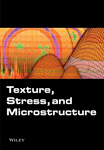High-Energy X-Rays: A tool for Advanced Bulk Investigations in Materials Science and Physics
Abstract
High-energy X-rays between 30 keV and 1MeV, such as provided by modern synchrotron radiation sources as the ESRF and HASYLAB, bear the advantage of high penetration into most materials. Even heavy element compositions can be accessed in their volume. The range of applications is huge and spreads from nuclear spectroscopy to the characterization of metal extrusion under industrial conditions. This article compiles an overview over the most common instrumental diffraction techniques.
Modern two-dimensional detectors are used to obtain rapid overviews in reciprocal space. For example, diffuse scattering investigations benefit from the very flat Ewald sphere as compared to low energies, which allow mapping of several Brillouin zones within one single shot. Diffraction profiles from liquids or amorphous materials can be recorded easily. For materials science purposes, whole sets of Debye–Scherrer rings are registered onto the detector, their diameters and eccentricities or their intensity distribution along the rings relating to anisotropic strain or texture measurements, respectively. At this point we stress the resolution of this technique which has to be carefully taken into account when working on a second generation synchrotron source.
Energy-dispersive studies of local residual strain can be studied by a dedicated three-circle diffractometer which allows accurately to adjust the scattering angle from a defined gauge volume.
Triple axis diffractometry and reciprocal space mapping is introduced and can be employed for highest resolution purposes on single crystal characterization, even under heavy and dense sample environments. Thus, the perfection of single crystals can be mapped and strain fields and superstructures as introduced by the modulation from ultrasonic waves into crystals or epitaxially grown Si/Ge layers can be investigated in detail. Phase transitions as magnetic ordering can be studied directly or through its coupling to the crystal lattice. Time resolved studies are performed stroboscopically from a sub-nanosecond to a second time scale.
The combination of these techniques is a strong issue for the construction and development of future instruments.




